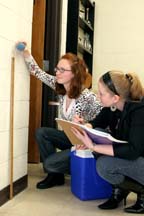from Erica Jacobsen, JCE High School Editor
As I write this, the garden is winding down for the season. The time is ripe (pun intended) for reflection. What worked? What didn’t? A new addition this year was zucchini. We tested the waters with just a single plant and it kept us easily supplied for sauteeing with fresh garlic. We’ll grow one again next year. We continued raising sweet, golden varieties of heirloom tomatoes. They grew okay, but didn’t ripen as well as expected. Perhaps we should move them to an even warmer spot? Cilantro for salsa has been a complete bust for two years running. Next year I’ll just visit the grocery store when I need it. Planning now while this season is still fresh in my mind gives me a head start on making next season even better.
The article by Mahalingam, Schaefer, and Morlino in the November 2008 issue of the Journal of Chemical Education is an example of making adjustments to fit a situation as one finds what works best, even in the midst of performing chemical education research in the classroom. They state “Because it was the first year of implementation, several aspects of the model were found to hamper group interaction and were not used in subsequent years.” A common thread through Laura’s Especially columns that appear in JCE and also these blog posts is also one of reflection and possible adjustment. Effective teachers make frequent checks: Is this working for my students? Is there a different way to help them learn this material even better?
Material published by the Journal can benefit from reflection as well, particularly the special issues created for National Chemistry Week (NCW) and Chemists Celebrate Earth Day, published in October and February, respectively. JCE will publish its tenth NCW issue next year. What works? What doesn’t? What do you usually use with your students? What do you tend to skip? How can we make it an even better issue? We need your comments. Please email me or post a comment at this blog entry. Let’s discuss what might be tweaked, or even recreated, in these issues.
One piece of the NCW issue I’d specifically like feedback on is the JCE Classroom Activity. We go to great lengths to publish an Activity that matches the American Chemical Society’s selected theme for the year. However, as I state in this month’s Classroom Activity Connections, identifying an author or submission to fit the theme can be hit or miss. Kuntzleman, Sellers, and Hoffmeyer had a great activity to fit the October 2008 NCW issue. Unfortunately, I didn’t meet Kuntzleman and happen to hear about the idea until it was too late. Instead, we bring it to you now, with its multiple ways to extend the already published October 2008 JCE Classroom Activity.
Stephanie Ling (left) prepares to test the properties of a racquet ball while Rachel Hoffmeyer (right) takes notes. Photo by Stephanie Ling.
We want to share the great things you do in your classroom that relate to these themes, but we don’t know about them unless you share with us! The NCW issue is geared toward high school teachers and their students. Shouldn’t it contain content written by those teachers? Please consider this a personal invitation to contribute to our special issues. The upcoming themes are:
NCW 2009: Chemistry—It’s Elemental (periodic table)
NCW 2010: Behind the Scenes with Chemistry (includes movie special effects and things regarded as “magic”)
Chemists Celebrate Earth Day: The general topics are on a repeating four-year cycle. Upcoming themes are: air (2009); plants and soil (2010); recycling (2011); water (2012).
Laura’s Take on the Issue
from Laura Slocum, JCE High School Associate Editor
The ongoing controversy in regard to the placement of lanthanum, La, and actinium, Ac, continues; Lavelle makes a strong argument for leaving them in the d-block in his article. I know that in my 18 years of teaching, most of my students have wondered why they are in the d-block and then the f-block series are named the “lanthanides” and “actinides”. I think it is a valid question for them to ask, and we need to be ready to answer their questions.
Samide’s game about helping students to understand chromatography really interested me too. His comment, “While the models used in the classroom may not represent a system with complete accuracy, they serve in helping a student bridge the gap between abstract concepts and reality”, stated clearly one of the reasons why I have adopted the use of models in my classroom. I am looking forward to trying this game with my AP chemistry students when we study chromatography in February.
Like Erica, I strongly encourage you to provide feedback on the special issues for National Chemistry Week and Chemists Celebrate Earth Day. Erica and I are both here to help you in any way we can to share your idea through the Journal with other chemistry teachers.




* You can follow any responses to this entry through the RSS 2.0 feed.